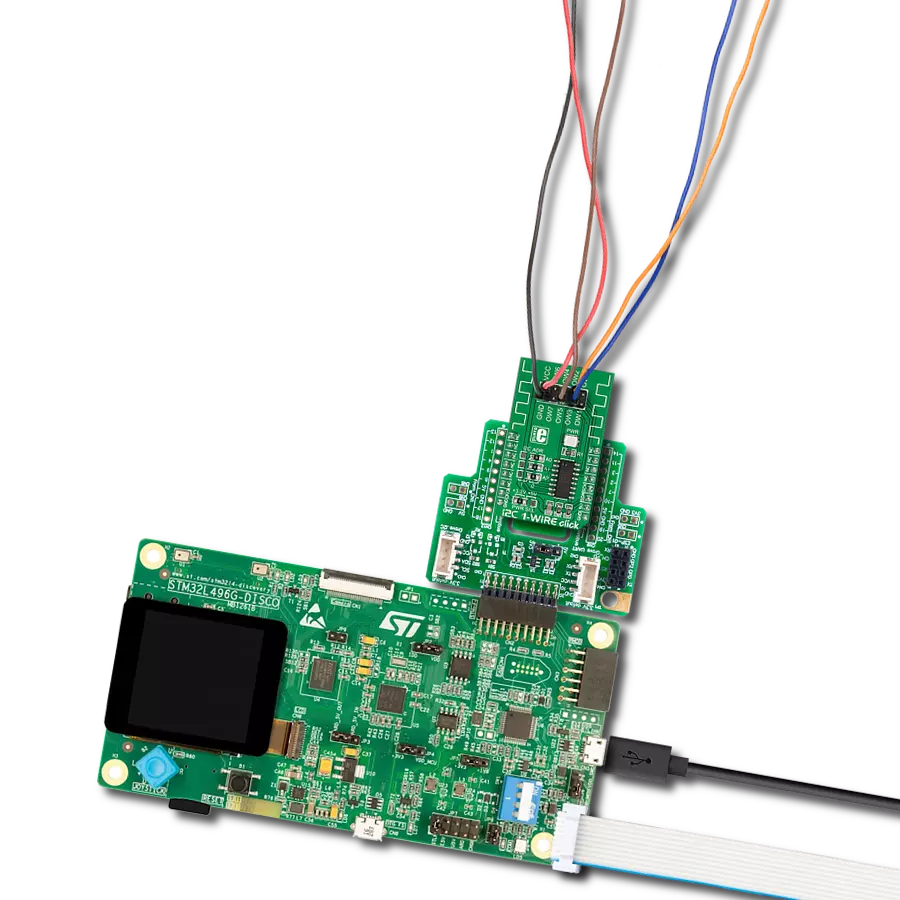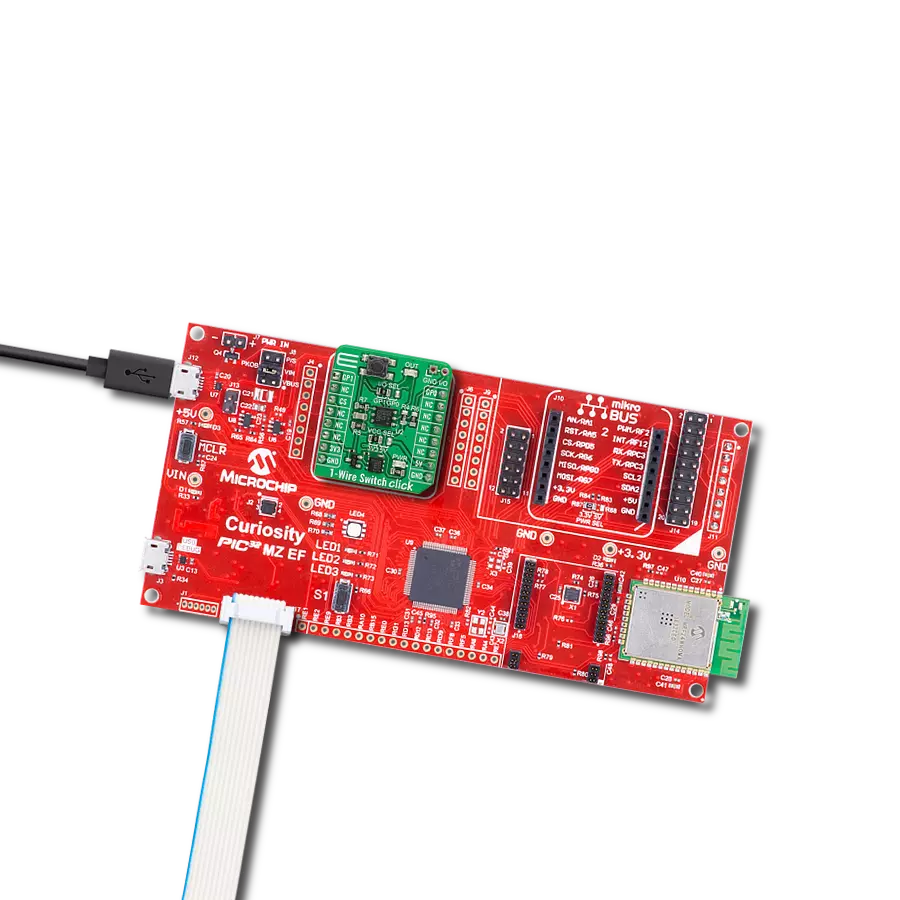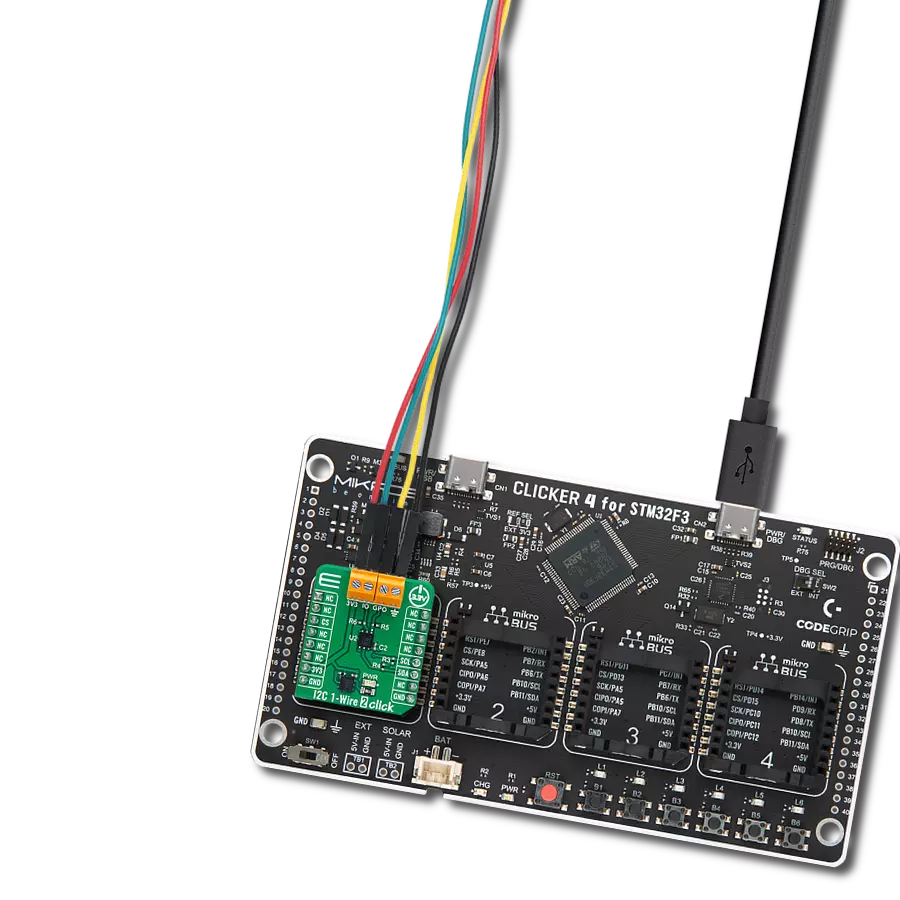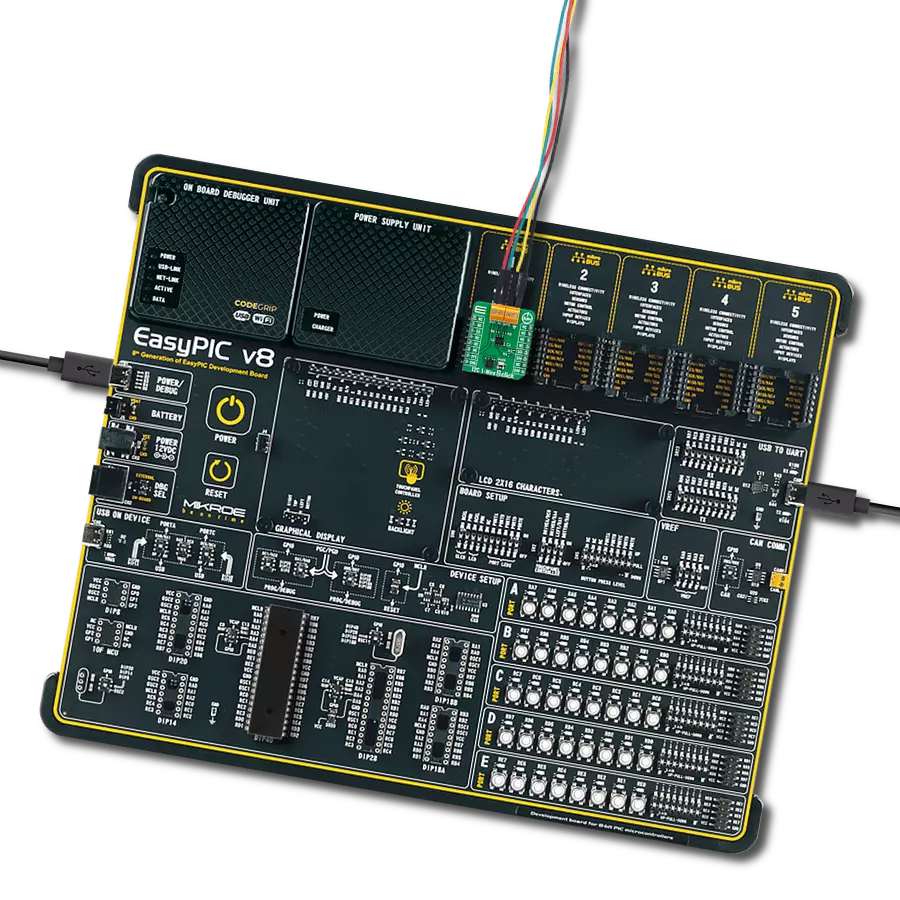Upgrade your engineering game with the simplicity of 1-Wire and the versatility of I2C today!
A
A
Hardware Overview
How does it work?
I2C 1-Wire Click is based on the DS2482-800, a self-timed 8-channel 1-Wire master (relative to any attached 1-Wire slave device) from Analog Devices, performing bidirectional conversions between I2C master and 1-Wire slave devices. To optimize 1-Wire waveform generation, the DS2482-800 performs slew-rate control on rising and falling 1-Wire edges. It also has a programmable feature to mask the fast presence pulse edge that some 1-Wire slave devices can generate and programmable strong pull-up features that supports 1-Wire power delivery to 1-Wire devices such as EEPROMs, temperature sensors, and similar devices with momentary high source current modes. The DS2482-800 communicates
with an MCU using the standard I2C 2-Wire interface to read data and configure settings, supporting Fast Mode up to 400kHz. Once supplied with command and data, the I/O controller of the DS2482-800 performs time-critical 1-Wire communication functions such as reset/presence detect cycle, read-byte, write-byte, single-bit R/W and triplet for ROM search without requiring interaction with the host MCU. The host MCU obtains feedback and data (completion of a 1-Wire function, presence pulse, 1-Wire short, search direction taken) through the status and reads data registers. The DS2482-800 has a 7-bit slave address with the first four MSBs fixed to 0011. The address pins, A0, A1, and A2, are programmed
by the user and determine the value of the last three LSBs of the slave address, allowing up to 8 devices to operate on the same bus segment. The value of these address pins can be set by positioning onboard SMD jumpers labeled as I2C ADR to an appropriate position marked as 1 or 0. This Click board™ can operate with both 3.3V and 5V logic voltage levels selected via the PWR SEL jumper. This way, it is allowed for both 3.3V and 5V capable MCUs to use the communication lines properly. However, the Click board™ comes equipped with a library containing easy-to-use functions and an example code that can be used, as a reference, for further development.
Features overview
Development board
Arduino UNO is a versatile microcontroller board built around the ATmega328P chip. It offers extensive connectivity options for various projects, featuring 14 digital input/output pins, six of which are PWM-capable, along with six analog inputs. Its core components include a 16MHz ceramic resonator, a USB connection, a power jack, an
ICSP header, and a reset button, providing everything necessary to power and program the board. The Uno is ready to go, whether connected to a computer via USB or powered by an AC-to-DC adapter or battery. As the first USB Arduino board, it serves as the benchmark for the Arduino platform, with "Uno" symbolizing its status as the
first in a series. This name choice, meaning "one" in Italian, commemorates the launch of Arduino Software (IDE) 1.0. Initially introduced alongside version 1.0 of the Arduino Software (IDE), the Uno has since become the foundational model for subsequent Arduino releases, embodying the platform's evolution.
Microcontroller Overview
MCU Card / MCU

Architecture
AVR
MCU Memory (KB)
32
Silicon Vendor
Microchip
Pin count
28
RAM (Bytes)
2048
You complete me!
Accessories
Click Shield for Arduino UNO has two proprietary mikroBUS™ sockets, allowing all the Click board™ devices to be interfaced with the Arduino UNO board without effort. The Arduino Uno, a microcontroller board based on the ATmega328P, provides an affordable and flexible way for users to try out new concepts and build prototypes with the ATmega328P microcontroller from various combinations of performance, power consumption, and features. The Arduino Uno has 14 digital input/output pins (of which six can be used as PWM outputs), six analog inputs, a 16 MHz ceramic resonator (CSTCE16M0V53-R0), a USB connection, a power jack, an ICSP header, and reset button. Most of the ATmega328P microcontroller pins are brought to the IO pins on the left and right edge of the board, which are then connected to two existing mikroBUS™ sockets. This Click Shield also has several switches that perform functions such as selecting the logic levels of analog signals on mikroBUS™ sockets and selecting logic voltage levels of the mikroBUS™ sockets themselves. Besides, the user is offered the possibility of using any Click board™ with the help of existing bidirectional level-shifting voltage translators, regardless of whether the Click board™ operates at a 3.3V or 5V logic voltage level. Once you connect the Arduino UNO board with our Click Shield for Arduino UNO, you can access hundreds of Click boards™, working with 3.3V or 5V logic voltage levels.
Used MCU Pins
mikroBUS™ mapper
Take a closer look
Click board™ Schematic

Step by step
Project assembly
Software Support
Library Description
This library contains API for I2C 1-Wire Click driver.
Key functions:
i2conewire_setChannel - Set the channel function..
i2conewire_writeByteOneWire - Generic One Wire writes the byte of data function.
i2conewire_readByteOneWire - Generic One Wire read the byte of data function.
Open Source
Code example
The complete application code and a ready-to-use project are available through the NECTO Studio Package Manager for direct installation in the NECTO Studio. The application code can also be found on the MIKROE GitHub account.
/*!
* \file
* \brief I2C1Wire Click example
*
* # Description
* This example showcases how to initialize, confiure and use the I2C 1-Wire Click. The Click
* is a I2C (host) to 1-Wire interface (slave). In order for the example to work one or more
* 1-Wire (GPIO) Click modules are required. Gnd goes to gnd, power goes to power and the cha-
* nnels are there to read data from connected modules.
*
* The demo application is composed of two sections :
*
* ## Application Init
* This function initializes and configures the logger and Click modules.
*
* ## Application Task
* This function reads all of the channels on the Click module and displays any data it acqu-
* ires from them with a 100 millisecond delay.
*
*
* \author MikroE Team
*
*/
// ------------------------------------------------------------------- INCLUDES
#include "board.h"
#include "log.h"
#include "i2c1wire.h"
// ------------------------------------------------------------------ VARIABLES
static i2c1wire_t i2c1wire;
static log_t logger;
// ------------------------------------------------------ APPLICATION FUNCTIONS
void application_init ( )
{
log_cfg_t log_cfg;
i2c1wire_cfg_t cfg;
/**
* Logger initialization.
* Default baud rate: 115200
* Default log level: LOG_LEVEL_DEBUG
* @note If USB_UART_RX and USB_UART_TX
* are defined as HAL_PIN_NC, you will
* need to define them manually for log to work.
* See @b LOG_MAP_USB_UART macro definition for detailed explanation.
*/
LOG_MAP_USB_UART( log_cfg );
log_init( &logger, &log_cfg );
log_info( &logger, "---- Application Init ----" );
// Click initialization.
i2c1wire_cfg_setup( &cfg );
I2C1WIRE_MAP_MIKROBUS( cfg, MIKROBUS_1 );
i2c1wire_init( &i2c1wire, &cfg );
Delay_1sec( );
}
void application_task ( )
{
uint8_t chan_state = 0;
uint8_t cnt_chan = 0;
uint8_t cnt_val = 0;
uint8_t id_code[ 9 ] = { 0 };
chan_state = 1;
i2c1wire_soft_reset( &i2c1wire );
Delay_10ms( );
i2c1wire_set_config( &i2c1wire, I2C1WIRE_CONFIG_1WS_HIGH |
I2C1WIRE_CONFIG_SPU_HIGH |
I2C1WIRE_CONFIG_APU_LOW );
Delay_10ms( );
for ( cnt_chan = 0; cnt_chan < 8; cnt_chan++ )
{
i2c1wire_set_channel( &i2c1wire, cnt_chan );
i2c1wire_one_wire_reset( &i2c1wire );
Delay_10ms( );
i2c1wire_write_byte_one_wire( &i2c1wire, I2C1WIRE_WIRE_COMMAND_READ_ROM );
Delay_10ms();
for ( cnt_val = 8; cnt_val > 0; cnt_val-- )
{
id_code[ cnt_val ] = i2c1wire_read_byte_one_wire( &i2c1wire );
if ( id_code[ cnt_val ] == I2C1WIRE_WIRE_RESULT_OK )
{
log_printf( &logger, "\r\n Channel %d : No device on the channel\r\n", ( uint16_t ) cnt_chan );
Delay_100ms( );
break;
}
else if ( chan_state )
{
log_printf( &logger, " Channel %d : ID = 0x", ( uint16_t ) cnt_chan );
chan_state = 0;
}
log_printf( &logger, "%d", ( uint16_t ) id_code[ cnt_val ] );
Delay_10ms( );
}
log_printf( &logger, "\r\n---------------------------------------\r\n" );
}
log_printf( &logger, "***\r\n" );
}
int main ( void )
{
/* Do not remove this line or clock might not be set correctly. */
#ifdef PREINIT_SUPPORTED
preinit();
#endif
application_init( );
for ( ; ; )
{
application_task( );
}
return 0;
}
// ------------------------------------------------------------------------ END
Additional Support
Resources
Category:1-Wire


































